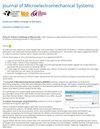Exploring Bias-Instability Noise Sources in Quadrature Error Compensation System for Mode-Split MEMS Gyroscopes
IF 3.1
3区 工程技术
Q2 ENGINEERING, ELECTRICAL & ELECTRONIC
引用次数: 0
Abstract
In this paper, bias instability (BIS) and angle random walk (ARW) noise sources of quadrature correction for mode-split MEMS gyroscopes are first investigated. We propose a general noise model based on coupling stiffness correction that reveals the transfer mechanism of 1/f and white noise sources. The BIS with a small frequency split is mainly dominated by the electrostatic frequency-tuning voltage noise and that with a large frequency split is determined by the voltage reference noise in the quadrature loop. Due to the electrostatic frequency-tuning voltage noise, the quadrature correction system is unable to compensate for the quadrature error to zero. The BIS with quadrature correction is related to the initial quadrature error and frequency split. We find a good match between the presented model and measurements with an error of less than 15.1%. The simulation and experimental results have indicated that ARW will not be deteriorated by the quadrature compensation system. A MEMS mode-split gyroscope has achieved an ARW of分模MEMS陀螺仪正交误差补偿系统中偏置不稳定噪声源的研究
本文首先研究了分模MEMS陀螺仪正交校正的偏置不稳定性(BIS)和角度随机漫步(ARW)噪声源。我们提出了一个基于耦合刚度校正的通用噪声模型,揭示了1/f和白噪声源的传递机理。分频小的BIS主要由静电调频电压噪声决定,分频大的BIS主要由正交回路中的参考电压噪声决定。由于静电调频电压噪声,正交校正系统无法将正交误差补偿为零。经正交校正后的BIS与初始正交误差和分频有关。我们发现所提出的模型与测量值吻合良好,误差小于15.1%。仿真和实验结果表明,正交补偿系统不会使ARW变差。在初始正交130~^{\circ}$ /s和正交误差补偿下的85 Hz分频下,MEMS分模陀螺仪的ARW为$0.029~^{\circ}$ / $ $ $ $ / $ $ $ $, BIS为$0.08~^{\circ}$ /h。(2025 - 0014)
本文章由计算机程序翻译,如有差异,请以英文原文为准。
求助全文
约1分钟内获得全文
求助全文
来源期刊

Journal of Microelectromechanical Systems
工程技术-工程:电子与电气
CiteScore
6.20
自引率
7.40%
发文量
115
审稿时长
7.5 months
期刊介绍:
The topics of interest include, but are not limited to: devices ranging in size from microns to millimeters, IC-compatible fabrication techniques, other fabrication techniques, measurement of micro phenomena, theoretical results, new materials and designs, micro actuators, micro robots, micro batteries, bearings, wear, reliability, electrical interconnections, micro telemanipulation, and standards appropriate to MEMS. Application examples and application oriented devices in fluidics, optics, bio-medical engineering, etc., are also of central interest.
 求助内容:
求助内容: 应助结果提醒方式:
应助结果提醒方式:


